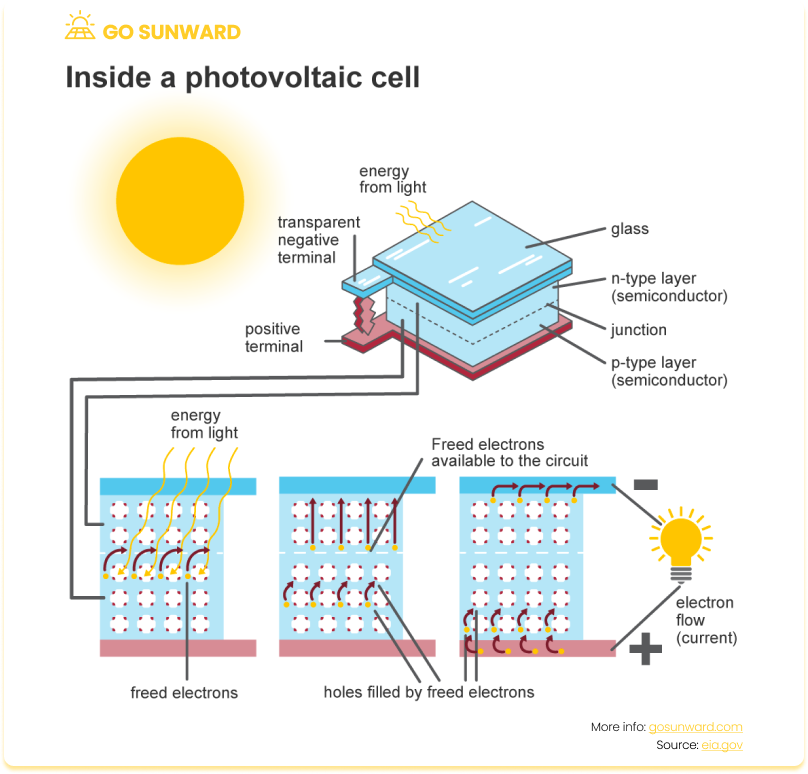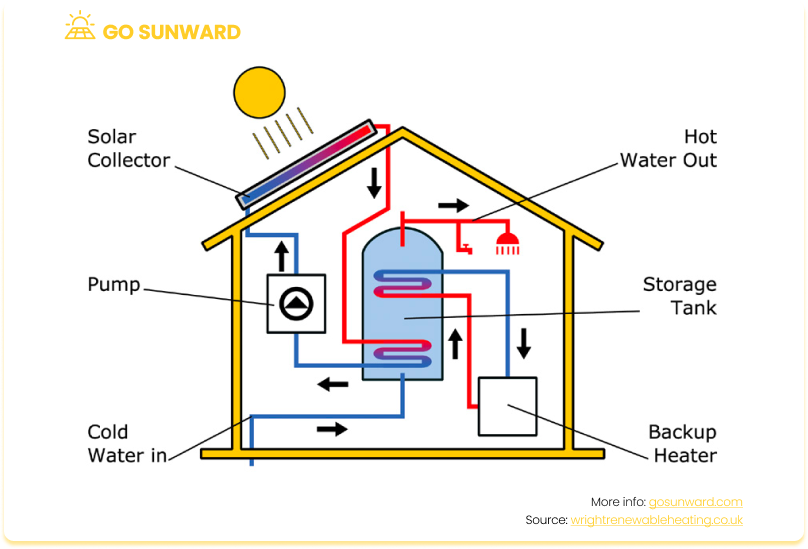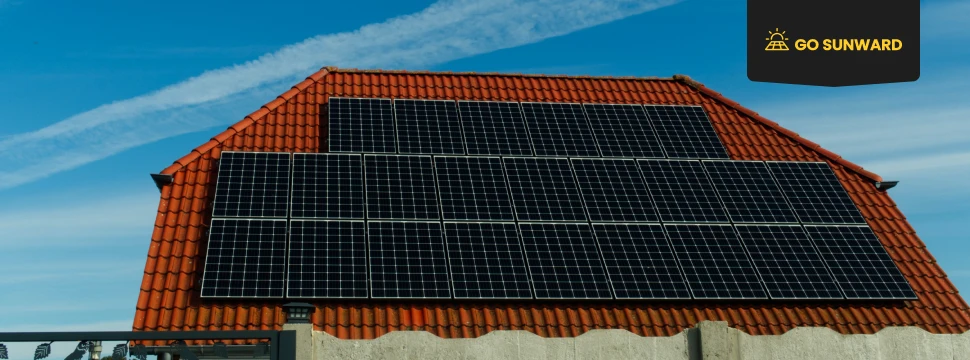How Do Solar Panels Reduce CO2 Emissions?
Solar panels have become increasingly popular as a clean and sustainable energy source at both the utility-scale and residential levels. One of the main advantages of solar panels is their ability to reduce carbon dioxide (CO2) emissions. By harnessing solar energy through panels, we can reduce our reliance on fossil fuels, mitigate CO2 emissions, and transition towards a more sustainable, low-carbon global energy system.
This blog will explore how solar panels reduce CO2 emissions and explain why solar panel technology is set to play such a key role in combating climate change. There are three main ways that solar panels reduce CO2 emissions, we’ll cover each in detail below.
1. Solar Panels Reduce CO2 Emissions By: Harnessing Low Carbon Solar Energy
To understand how solar panels reduce CO2 emissions, we must first take a closer look at the energy production process from solar panels, both in terms of electricity and heat generation.
Solar panels convert sunlight into electricity through a process called photovoltaic (PV) conversion. Solar panels are typically composed of semiconductor materials, such as silicon, with specialized layers designed to facilitate the conversion of sunlight into usable electricity. When sunlight, which consists of tiny particles of energy called photons, reaches the surface of the solar panel, it interacts with the semiconductor material. This interaction energizes electrons within the material, causing them to break free from their atomic bonds.
As electrons, each carrying a negative charge, move toward the front surface of the solar cell, an electrical imbalance arises between the cell’s front and back surfaces. This imbalance generates a voltage potential, similar to a battery’s positive and negative terminals. The electrical conductors on the cell absorb these electrons. When the conductors are connected to an external load, like a battery, electricity flows through the circuit.

In addition, solar panels can be used for domestic heating purposes. This application is commonly referred to as ‘solar thermal’ or ‘solar water heating’. While solar panels primarily convert sunlight into electricity through photovoltaic conversion, as outlined above, a different type of solar panel, known as a solar thermal collector, is designed to capture solar energy to heat water or other fluids directly. One of the most common applications of solar thermal technology is domestic water heating, but it can also be used for space heating.

2. Solar Panels Reduce CO2 Emissions By: Offsetting Fossil Fuel Consumption For Heating & Electricity
For many decades, energy markets and the global electricity system have been predominantly centered around thermal sources, primarily oil, gas, and coal. These fossil fuels have played a central role in meeting the world’s energy demand due to their historical availability, relatively low costs, and established infrastructure for extraction, transportation, and power generation.
However, as concerns about global warming have risen and efforts to reduce carbon footprints have accelerated, renewable energy sources have come into the spotlight given their low-carbon nature. Additionally, technology costs for renewable energy, particularly solar, have fallen dramatically over recent decades, making them an increasingly affordable option for electricity generation. According to the International Renewable Energy Agency (IRENA), solar PV has seen the steepest cost decline of any electricity source over the last decade. Notably, the price of utility-scale solar PV has experienced an 82% decline between 2010 and 2020, with a significant cost reduction of 13% in 2021 alone.
By using solar panels to generate electricity or for heating purposes, individuals, businesses, and policymakers can significantly reduce reliance on fossil fuels, offsetting consumption. The more solar energy is used, the less fossil fuel-based electricity is needed. This reduction in fossil fuel consumption directly translates into lower CO2 emissions.
3. Solar Panels Reduce CO2 Emissions By: Lower Lifecycle Emissions
It is essential to also consider lifecycle emissions when answering the question of how solar panels reduce CO2 emissions. The lifecycle emissions associated with solar panels include those generated during various stages of their production, transportation, installation, and eventual disposal. While these emissions are not zero, they are significantly lower when compared to the CO2 emissions that would have been generated had conventional fossil fuel-based electricity sources been used to produce the same amount of electricity over the panels’ operational lifetime.
Over the lifespan of a solar panel (typically 25 to 30 years or more), the clean electricity it produces offsets the CO2 emissions that would have been released if the same electricity had been generated from fossil fuels. This net emissions reduction can be substantial, as solar power replaces conventional electricity sources responsible for significant CO2 emissions.
The time it takes for a solar panel to ‘pay back’ the CO2 emissions associated with its manufacturing and installation is known as the “carbon payback period.” This period has decreased over time due to more energy-efficient manufacturing processes and cleaner energy grids. In many cases, the carbon payback period is relatively short, typically a few years, after which the solar panel continues to deliver emissions-free electricity for decades.
So How Much CO2 Can Be Reduced Through Solar Panels?
We have now examined how solar panels reduce CO2 emissions, but exactly how much CO2 can be reduced through solar panel usage?
The answer is not straightforward, given that the exact reduction in CO2 emissions depends on several factors, including the size of the solar panel system, the technology deployed, the location and climate, and the energy demands of the property or grid network.
On average, a residential solar panel system can offset approximately 3-4 tons of CO2 emissions per year. This is equivalent to planting around 100 trees or not driving a car for over 10,000 miles. Larger commercial solar panel systems can have an even greater impact, offsetting several hundred tons of CO2 emissions annually. For example, on average, a utility-scale solar PV project can reduce CO2 emissions by around 0.4 to 0.7 metric tons per megawatt-hour (MWh) of electricity generated.
To get a more accurate estimate of how much CO2 can be reduced by installing solar panels at your property, it is recommended to consult with a professional solar panel installer who can carry out full assessments of your specific situation, provide a detailed analysis, and formulate a comprehensive strategy to adopt. Overall, installing solar panels offers a significant opportunity to reduce CO2 emissions, combat climate change, and reduce energy costs.
What are the other environmental benefits of using solar panels?
As you can see above, solar panels are an innovative technology that harnesses the power of the sun to generate clean and renewable energy. As our world continues to face the challenges of climate change and the need to reduce carbon emissions, solar panels have become an increasingly popular sustainable solution across the globe.
In fact, the use of solar panels is not only critical for emissions reduction, but they also have additional environmental benefits, as outlined below.
Solar panels have a positive impact on air and water quality. Unlike fossil fuel power plants, solar panels do not emit pollutants such as sulfur dioxide, nitrogen oxide, or particulate matter, which are known to contribute to air pollution and respiratory issues. This reduction in air pollutants leads to improved air quality and healthier communities. This translates into fewer hospital admissions, reduced healthcare costs, and an overall improvement in the quality of life for communities near solar installations.
Solar panels also have minimal water usage compared to conventional energy sources. Traditional power plants often require large amounts of water for cooling purposes, which can strain local water resources and contribute to water scarcity. In contrast, solar panels do not require water for operation, reducing the strain on water supplies and preserving this valuable resource. The advantages of solar panels’ minimal water usage become particularly evident in regions facing water stress or drought conditions, which conditions are already being exacerbated by climate change. In such areas, the adoption of solar energy can alleviate pressure on already limited water supplies, easing the burden on local communities and agriculture.
Solar panels’ water-saving benefits extend beyond electricity generation. In applications like solar water heaters and desalination systems, solar energy directly provides hot water and fresh water, bypassing the need for traditional water-intensive heating methods or desalination processes that often rely on fossil fuels.
Another environmental benefit of solar panels is the conservation of natural habitats and landscapes. Conventional energy sources, such as coal mining and natural gas extraction, often necessitate extensive land clearance and disruption of ecosystems, leading to deforestation, habitat loss, and irreversible damage to biodiversity. In contrast, solar panels offer a unique opportunity to harness clean energy without causing significant harm to the natural world. Their versatility allows for installation in a variety of locations, including urban areas and previously disturbed lands, minimizing the need for new infrastructure development and protecting undisturbed wilderness.
By utilizing rooftops, parking lots, and brownfields for solar installations, we can maximize land use efficiency and reduce the pressure to convert pristine landscapes into industrial zones. This approach fosters the preservation of critical habitats for wildlife, protects native plant species, and maintains the ecological balance necessary for a healthy and resilient environment. Moreover, encouraging the development of solar projects on unused or degraded lands presents an opportunity for land restoration and reclamation. Former mining sites or abandoned industrial areas can be repurposed for solar energy generation, transforming once-scarred lands into productive and environmentally responsible assets.
It is important to note that while solar panels have numerous environmental benefits, their installation and maintenance should be carried out responsibly. This includes properly disposing of old or damaged panels to avoid adding to electronic waste and ensuring that the manufacturing process remains sustainable and uses ethically sourced materials. If you install your solar panels using a company, please ensure they follow all these processes to ensure we protect our environment!
I think it’s safe to say that the use of solar panels has a significant positive impact on the environment. Solar panels mitigate greenhouse gas emissions, improve air and water quality, conserve natural habitats, and reduce reliance on fossil fuels. As the world continues to transition towards renewable energy sources, we predict that solar panels will play a crucial role in combating climate change and creating a sustainable future.
Conclusion
In conclusion, solar panels offer a dual advantage in reducing CO2 emissions by generating electricity and heat through renewable and clean energy sources. In electricity generation, photovoltaic solar panels convert sunlight directly into electricity without producing any greenhouse gas emissions, thus replacing the need for fossil fuel-based power generation and mitigating CO2 emissions from conventional power plants. Additionally, solar thermal systems, which capture solar energy to produce heat, contribute to further CO2 reduction by providing emission-free heating solutions for domestic and commercial purposes. By embracing solar technology, we can significantly progress in combating climate change, reducing our environmental impacts and transitioning to a low-carbon energy future.




